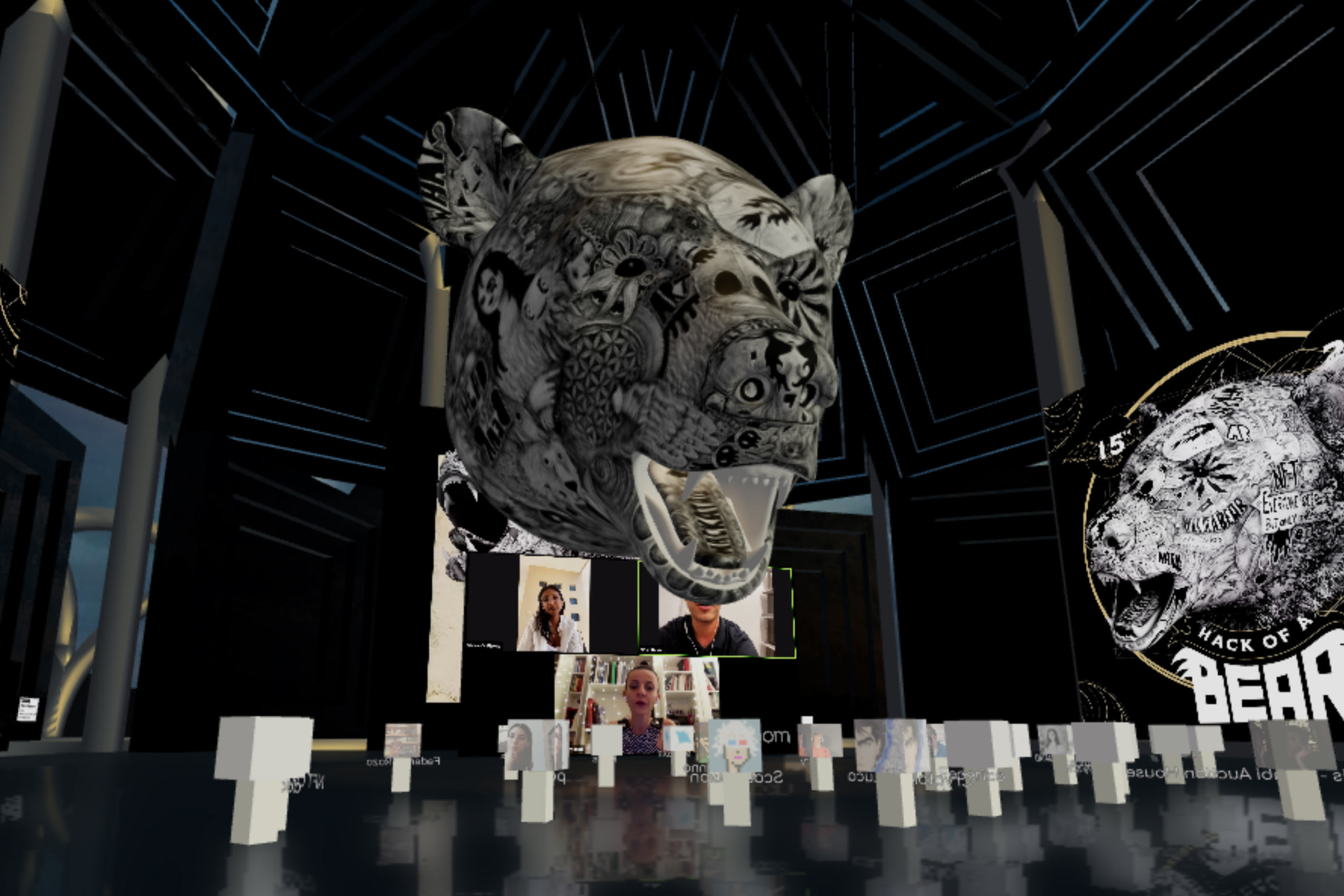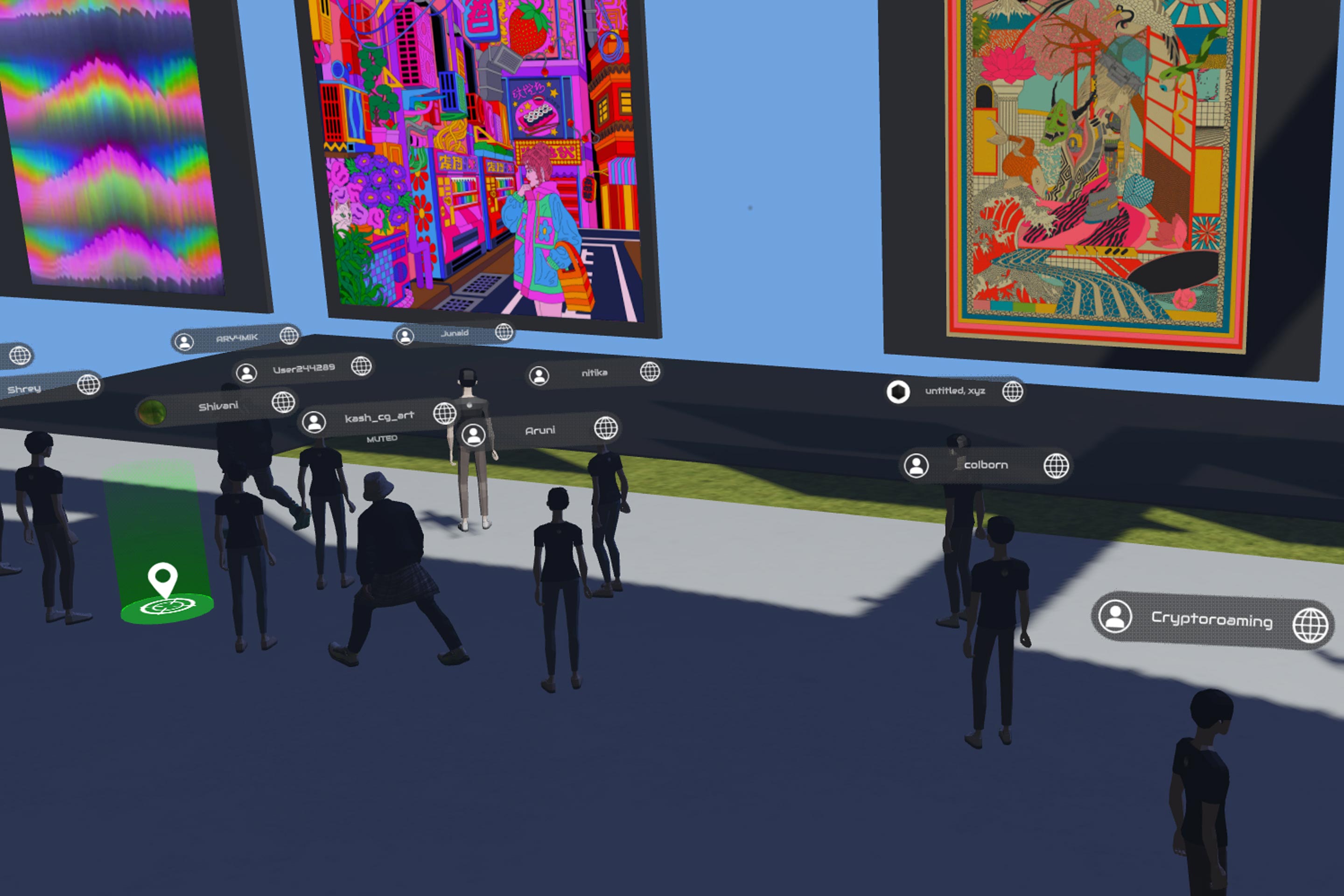一位NFT收藏者自称藏品价值百万,却不看好市场前景
科尔伯恩·贝尔拥有常青藤名校学历,从事的是令人羡慕的投资银行家的工作,几年前,他走的还是传统职业路线。但他对艺术品和NFT的热爱改变了这一切。
贝尔表示,他在2020年2月以一两百美元的价格购买了第一个NFT——艾尔·辛普森女士的《Lady Luck》。现在,他是加密艺术博物馆(Museum of Crypto Art)的创始人兼馆长。加密艺术博物馆是一个虚拟展览空间和文化机构,目前在元宇宙平台Somnium Space上运营。

cryptoart.io网站的信息显示,对互联网感兴趣的任何人都可以欣赏该博物馆收藏的近6,000件独一无二的NFT艺术品,包括全球十大畅销NFT艺术家中六位艺术家的作品。贝尔对于其中一件艺术品的定价约为1,500万美元,但他表示他不会出售任何一件藏品。
贝尔对《财富》杂志表示:“我们获得授权呈现艺术家和收藏品的故事。这个基本理念意味着我们不能出售这些艺术品,所以我们不会参与NFT市场。”
虽然贝尔对于他的博物馆和NFT艺术品雄心勃勃,但他并不看好NFT艺术品市场的未来,至少对按当前形式运行的市场并不乐观。
贝尔表示:“我想我已经做好了迎接一次灾难性的市场崩溃的准备。”
从银行业到NFT艺术品收藏
2017年,贝尔首次购买以太币,从此开始涉足加密货币行业。他表示,当时他是一名理财经理,负责管理外国家庭的美国资产,之前的职业涉及发展金融和投资银行领域。
非同质化代币(NFT)是存储于区块链的不可交换数字资产,通常是数字格式的图片、视频或音频文件,可以像现实世界的资产一样出售、交易或租赁。
在了解到加密货币之后,贝尔发现他的背景让他具备了在一个平行金融世界中成功的完美技能。他感觉这些技能让他更有能力将自己的价值观与财富相结合。
他表示:“至少对于普通人而言,没有任何金融产品正在积极改变世界,或者给世界带来积极的重大影响。”
收藏品
贝尔在2020年2月购买了首个NFT,在不久之后的同年4月参与创建了加密艺术品博物馆,而NFT直到2021年春天才逐渐成为主流。
该博物馆的藏品分为两类,一类是Genesis系列,有200多个早期NFT艺术家创作的NFT,另外一类是Community系列,包括由社区艺术家捐赠的5,500多个NFT。
贝尔个人捐赠了150个Genesis系列NFT。该系列只包括2020年12月之前创作的NFT,该博物馆称这些NFT是“区块链上最早的痕迹”。
Genesis系列藏品的许多创作者从事NFT职业大获成功。cryptoart.io网站上的信息显示,该系列中包括艺术家Beeple和Pak的早期作品。2021年3月,Beeple创作的一个NFT在佳士得拍卖行(Christie’s)拍出了6,900万美元的天价。而Pak是目前全球销量最高的NFT艺术家。其他知名艺术家还包括德米特里·切尼亚克,其NFT平均售价高达近10万美元,另外一位艺术家xcopy早期的NFT作品单个售价高达600万美元。
贝尔表示,他的职责是“让每一位艺术家在历史上拥有一席之地,证明他们是‘淘金热’的先行者,并真正让NFT市场不断壮大,从雪球变成一场雪崩。”

Community系列藏品则是由艺术家们捐赠的NFT。贝尔表示,这些NFT可以帮助“更生动地展现当前所发生的一切和人们所关注的话题。”
艺术家们向博物馆捐赠自己的作品,可以交换博物馆发行的加密货币MOCA币,成为社区成员。销售MOCA币是博物馆创收的途径之一。MOCA币的持有者可以积极参与展览策划的投票选举。该博物馆共发行了1,000万枚MOCA币,目前的交易单价约为3美元。
这两个系列收藏品均在虚拟平台Somnium Space上展出。访客登陆Somnium和进入博物馆之前,首先需要在Somnium网站下载软件,保证他们的设备符合要求,然后创建一个虚拟形象就可以参观虚拟博物馆。
贝尔在纽约州金斯敦买下了一栋19世纪的教堂,正在将其改造成一座现实世界的博物馆。他对于博物馆的构想是一个虚拟与现实相结合的空间。贝尔将在金斯敦举办线下活动,他同时还计划在Somnium Space和其他元宇宙平台推出虚拟“房间”功能,为艺术家和社区成员提供工具,在开放数字世界策划和展出自己的作品。

NFT艺术品市场将走向何方?
虽然贝尔对于NFT艺术品充满热情,对自己的博物馆也有雄心勃勃的计划,但他对以当前形式运行的NFT艺术品市场的前景却持怀疑态度,并批评了该领域过高的价格和日益严重的排他性。
贝尔称:“艺术家的进入门槛远低于收藏者的进入门槛。”他表示,越来越多新艺术家期待有人购买自己的作品,艺术家数量增长的速度远远超过愿意进行投资的收藏者的增加速度。
他说道:“我认为这种模式不会成功。”
他认为,由于NFT的多样化和平民化,这个领域正在快速变得过度饱和,因此他高度怀疑该领域按当前的形式能否长期存在下去。
他解释说:“有一种观点是将万物都变成NFT,因为现在NFT有很高的价值。”
他说道:“这时候情况会变得像金融泡沫一样非常危险。”
贝尔决定博物馆的任何收藏品均不对外出售,即使是价值最高的艺术品,这是因为他认为需要通过这样做让该领域重新脚踏实地,重点展示他心目中有故事性的艺术品。他尤其希望以早期NFT艺术家为主的Genesis系列能够让NFT艺术品运动回归本源。
他说道:“加密艺术品始终是反主流文化的,面对当前对NFT的大肆商业化开发,博物馆有责任展现截然不同的态度。”(财富中文网)
翻译:刘进龙
审校:汪皓
科尔伯恩·贝尔拥有常青藤名校学历,从事的是令人羡慕的投资银行家的工作,几年前,他走的还是传统职业路线。但他对艺术品和NFT的热爱改变了这一切。
贝尔表示,他在2020年2月以一两百美元的价格购买了第一个NFT——艾尔·辛普森女士的《Lady Luck》。现在,他是加密艺术博物馆(Museum of Crypto Art)的创始人兼馆长。加密艺术博物馆是一个虚拟展览空间和文化机构,目前在元宇宙平台Somnium Space上运营。
cryptoart.io网站的信息显示,对互联网感兴趣的任何人都可以欣赏该博物馆收藏的近6,000件独一无二的NFT艺术品,包括全球十大畅销NFT艺术家中六位艺术家的作品。贝尔对于其中一件艺术品的定价约为1,500万美元,但他表示他不会出售任何一件藏品。
贝尔对《财富》杂志表示:“我们获得授权呈现艺术家和收藏品的故事。这个基本理念意味着我们不能出售这些艺术品,所以我们不会参与NFT市场。”
虽然贝尔对于他的博物馆和NFT艺术品雄心勃勃,但他并不看好NFT艺术品市场的未来,至少对按当前形式运行的市场并不乐观。
贝尔表示:“我想我已经做好了迎接一次灾难性的市场崩溃的准备。”
从银行业到NFT艺术品收藏
2017年,贝尔首次购买以太币,从此开始涉足加密货币行业。他表示,当时他是一名理财经理,负责管理外国家庭的美国资产,之前的职业涉及发展金融和投资银行领域。
非同质化代币(NFT)是存储于区块链的不可交换数字资产,通常是数字格式的图片、视频或音频文件,可以像现实世界的资产一样出售、交易或租赁。
在了解到加密货币之后,贝尔发现他的背景让他具备了在一个平行金融世界中成功的完美技能。他感觉这些技能让他更有能力将自己的价值观与财富相结合。
他表示:“至少对于普通人而言,没有任何金融产品正在积极改变世界,或者给世界带来积极的重大影响。”
收藏品
贝尔在2020年2月购买了首个NFT,在不久之后的同年4月参与创建了加密艺术品博物馆,而NFT直到2021年春天才逐渐成为主流。
该博物馆的藏品分为两类,一类是Genesis系列,有200多个早期NFT艺术家创作的NFT,另外一类是Community系列,包括由社区艺术家捐赠的5,500多个NFT。
贝尔个人捐赠了150个Genesis系列NFT。该系列只包括2020年12月之前创作的NFT,该博物馆称这些NFT是“区块链上最早的痕迹”。
Genesis系列藏品的许多创作者从事NFT职业大获成功。cryptoart.io网站上的信息显示,该系列中包括艺术家Beeple和Pak的早期作品。2021年3月,Beeple创作的一个NFT在佳士得拍卖行(Christie’s)拍出了6,900万美元的天价。而Pak是目前全球销量最高的NFT艺术家。其他知名艺术家还包括德米特里·切尼亚克,其NFT平均售价高达近10万美元,另外一位艺术家xcopy早期的NFT作品单个售价高达600万美元。
贝尔表示,他的职责是“让每一位艺术家在历史上拥有一席之地,证明他们是‘淘金热’的先行者,并真正让NFT市场不断壮大,从雪球变成一场雪崩。”
Community系列藏品则是由艺术家们捐赠的NFT。贝尔表示,这些NFT可以帮助“更生动地展现当前所发生的一切和人们所关注的话题。”
艺术家们向博物馆捐赠自己的作品,可以交换博物馆发行的加密货币MOCA币,成为社区成员。销售MOCA币是博物馆创收的途径之一。MOCA币的持有者可以积极参与展览策划的投票选举。该博物馆共发行了1,000万枚MOCA币,目前的交易单价约为3美元。
这两个系列收藏品均在虚拟平台Somnium Space上展出。访客登陆Somnium和进入博物馆之前,首先需要在Somnium网站下载软件,保证他们的设备符合要求,然后创建一个虚拟形象就可以参观虚拟博物馆。
贝尔在纽约州金斯敦买下了一栋19世纪的教堂,正在将其改造成一座现实世界的博物馆。他对于博物馆的构想是一个虚拟与现实相结合的空间。贝尔将在金斯敦举办线下活动,他同时还计划在Somnium Space和其他元宇宙平台推出虚拟“房间”功能,为艺术家和社区成员提供工具,在开放数字世界策划和展出自己的作品。
NFT艺术品市场将走向何方?
虽然贝尔对于NFT艺术品充满热情,对自己的博物馆也有雄心勃勃的计划,但他对以当前形式运行的NFT艺术品市场的前景却持怀疑态度,并批评了该领域过高的价格和日益严重的排他性。
贝尔称:“艺术家的进入门槛远低于收藏者的进入门槛。”他表示,越来越多新艺术家期待有人购买自己的作品,艺术家数量增长的速度远远超过愿意进行投资的收藏者的增加速度。
他说道:“我认为这种模式不会成功。”
他认为,由于NFT的多样化和平民化,这个领域正在快速变得过度饱和,因此他高度怀疑该领域按当前的形式能否长期存在下去。
他解释说:“有一种观点是将万物都变成NFT,因为现在NFT有很高的价值。”
他说道:“这时候情况会变得像金融泡沫一样非常危险。”
贝尔决定博物馆的任何收藏品均不对外出售,即使是价值最高的艺术品,这是因为他认为需要通过这样做让该领域重新脚踏实地,重点展示他心目中有故事性的艺术品。他尤其希望以早期NFT艺术家为主的Genesis系列能够让NFT艺术品运动回归本源。
他说道:“加密艺术品始终是反主流文化的,面对当前对NFT的大肆商业化开发,博物馆有责任展现截然不同的态度。”(财富中文网)
翻译:刘进龙
审校:汪皓
With an Ivy League degree and a coveted job as an investment banker, Colborn Bell was on a traditional career path just a few years ago. But his passion for art and NFTs changed all that.
Bell says he bought his first NFT—Lady Luck, by Miss Al Simpson—in February 2020 for a couple hundred dollars. Now, he’s the founder and curator of the Museum of Crypto Art, a primarily virtual exhibition space and cultural institution that currently exists in Somnium Space, a metaverse platform.
Anyone with an internet connection can drop in to see the museum’s collection of nearly 6,000 unique NFT art pieces, including works from six of the 10 top-selling NFT artists in the world, according to cryptoart.io. Bell prices one of his collections at around $15 million, but says he will never sell any of the pieces.
“We are mandated to tell the stories of the artists and the artwork that is in the collection,” Bell told Fortune. “This means the foundation has mandated never to sell it, so we really just kind of remove ourselves from the markets.”
And while Bell has big ambitions for his museum and NFT art, he’s not as optimistic about the future of the NFT art market, at least in its current form.
“I am prepared, I think, for a cataclysmic market crash,” Bell said.
From banking to NFT art collecting
Bell began dabbling in cryptocurrency in 2017 when he first bought Ethereum. At the time, he says he was working as a wealth manager, taking care of a foreign family’s U.S. holdings, and had worked in developmental finance and investment banking before that.
NFTs, or non-fungible tokens, are noninterchangeable digital assets stored on a blockchain. They usually take the form of a picture, video, or audio file in a digital format. NFTs can be sold, traded, or leased like any real-world asset.
After discovering cryptocurrency, Bell found that his background gave him the perfect skills to succeed in a parallel financial world, one that he felt offered him more agency to align his values with money.
“There were no financial products that were actually changing or having any material effect on the world in a positive direction, at least not for the average person,” Bell said.
The collections
Bell bought his first NFT in February 2020, well before NFTs became more mainstream in the spring of 2021. He cofounded and opened his crypto art museum soon after, in April 2020.
The museum consists of two separate collections: the Genesis collection, which houses over 200 NFTs minted by the very first NFT artists, and the Community collection, which consists of over 5,500 NFTs donated by community artists.
Bell personally donated 150 NFTs to the Genesis collection. It only includes NFTs that were minted before December 2020, which the museum calls “the earliest etchings on the blockchain.”
Some of the artists whose work is in the Genesis collection have gone on to incredibly successful NFT careers. That includes early work by the artist Beeple, who famously sold an NFT for $69 million at a Christie’s auction in March 2021, and Pak, who is currently the world’s highest-selling NFT artist, according to cryptoart.io. Other high-profile artists included in the collection are Dmitri Cherniak, whose average NFT sales clock in at almost $100,000, and xcopy, whose earliest NFTs have sold for as much as $6 million apiece.
Bell says his role is to “give everybody their place in history and prove that they were here before the gold rush, and really helped push the snowball down the hill to become the avalanche.”
The Community collection is made up of NFTs donated by artists. These help to “speak more to what is happening in the moment and what people care about,” according to Bell.
Artists become members of the community by giving the museum their art in exchange for the museum’s own cryptocurrency, known as MOCA Coin. Sales of the MOCA Coin are how the museum makes its money. Holders of MOCA Coin can actively vote on the curatorship of the museum. The museum has a fixed supply of 10 million tokens, which currently trade at around $3.
Both collections are displayed on the virtual platform Somnium Space. To access Somnium and enter the museum, visitors need to download software through Somnium’s website, ensuring that their device meets the requirements, before creating an avatar and accessing the virtual galleries.
Bell is also building the museum’s real-life home in a 19th-century church he purchased in Kingston, N.Y. He envisions the museum as a virtual-physical hybrid space. In-person events will be held at the Kingston location, but Bell also plans on launching a virtual “rooms” feature in Somnium Space and eventually other metaverse platforms that will give artists and members the tools to curate and exhibit their own work in open-access digital worlds.
Where does NFT art go from here?
Despite his passion for the NFT art world and his ambitions for the museum, Bell is skeptical about the prospects of the NFT art space in its current form, criticizing the sky-high prices and growing exclusivity of the field.
“The barrier to entry for artists is much lower than it is for collectors,” Bell said, adding that the number of new artists looking for someone to buy their work is far outpacing the number of collectors willing to invest.
“In my mind, that formula does not work,” he said.
He believes the field is quickly becoming oversaturated because of how versatile and accessible NFTs are, and it makes him doubtful that the space will survive very long in its current form.
“There is this idea of making everything an NFT, and just because it’s become an NFT, it’s now valuable,” he explains.
“For me, this is when it gets very dangerous and is akin to a financial bubble,” he said.
Bell’s decision to never sell even the museum’s most valuable pieces is what he believes is needed to bring the movement back down to earth and reprioritize the art that he believes can tell a story. He hopes his Genesis collection in particular, which spotlights the earliest NFT artists, can help bring the NFT art movement back to its roots.
“Crypto art was always countercultural, and it is a museum’s job to hold a place as the counternarrative to the rampant commercialization that is happening here,” he said.













